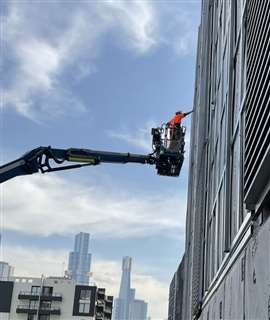How the world’s first major public body dedicated to cladding safety is working to solve the global crisis
13 November 2024
The Australian state of Victoria is pioneering a model aimed at assessing and removing combustible cladding on buildings after setting up the world’s first major public body dedicated to cladding safety. Lucy Barnard caught up with Dan O’Brien, chief executive of Cladding Safety Victoria to find out more.
From his office in a shiny blue and grey tower in the Melbourne Docklands, Dan O’Brien, chief executive of Cladding Safety Victoria (CSV) reels off a list of numbers.
“As of today, funded projects on 350 residential apartment buildings have been completed, remediation works on 130 schools, hospitals and police stations,” he says. “And a further 726 residential apartment buildings assessed as lower risk have been discharged from the program - making a total of 1,206 buildings in total with an outcome.”
 CSV work in progress. Photo: CSV
CSV work in progress. Photo: CSV
In fact, unlike many other jurisdictions which, seven years after the deadly Grenfell Tower fire shocked the world, are still grappling with the difficult problems of working out where dangerous combustible cladding has been installed and how to make it safe, Cladding Safety Victoria says it expects to complete most of its risk reduction work on the state’s high risk residential buildings by the end of 2025.
O’Brien, a mild-mannered former civil servant with a background in economics, has been leading one of the world’s first public bodies dealing primarily with cladding safety since it was established in December 2022 with A$600 million (US$398 million) of public funding.
It is progress which is being watched closely by governments, building owners, leaseholders and builders around the world, where many thousands of people have been left living in buildings possibly wrapped in the same aluminium composite material (ACM) panels used on the Grenfell Tower, rendering them impossible to sell or insure.
What is Cladding Safety Victoria?
Fresh from briefing the UK, Scottish and Irish governments, O’Brien says that the Victorian government has been pioneering a model of how to roll its sleeves up and get on with the difficult work of finding a solution for the global combustible cladding crisis.
Just a short walk away from O’Brien’s office in the Docklands is Lacrosse building, a block containing two 21-storey towers, one of which dramatically caught fire in 2014, and which was subsequently discovered to have used ACM cladding, prompting the Victorian government to start work identifying other buildings using similar cladding systems – work that was speeded up in 2017 in the wake of the Grenfell tragedy.
Under the CSV model, O’Brien says, the process has been broken down into three key stages; auditing cladding materials used on buildings; prioritizing the buildings with the highest risk for the quickest remediation work; and getting teams of contractors to remediate them – sometimes paid for by the state.
In 2017, a taskforce specially set up to deal with Victoria’s combustible cladding risks commissioned a state-wide audit which saw every residential building in scope with three storeys or more – a total of more than 2,000 buildings - assessed by a municipal building surveyor, either by examining building documents to see what sort of cladding was used or through on-site inspections.
 Dan O’Brien, chief executive of Cladding Safety Victoria. Photo: CSV
Dan O’Brien, chief executive of Cladding Safety Victoria. Photo: CSV
Data from the surveyors was then reviewed by an expert panel using a risk assessment tool which scored each building for fire danger based on the type of cladding used, the design of the building and the safety measures already in place. From this, buildings could then be ranked in terms of risk as either extreme, high, moderate or low.
The Victorian minister for planning then gave regulatory authority for buildings considered to be either extreme or high risk to CSV where they were again reassessed for cladding risk under a new Protocols for Mitigating Cladding Risk (PMCR) model which the body developed with the Royal Melbourne Institute of Technology and the Commonwealth Scientific Research Organisation with the buildings assessed a having the highest levels of risk eligible for state funding.
“There is no doubt that providing public funding for works on the most dangerous buildings was a key element of the speed and efficacy of the overall approach,” O’Brien says. “But the subsequent development of the PMCR methodology is the genuine game changer.”
“This approach has not only greatly assisted owners in terms of the financial impact and untangling what, for most had been a bureaucratic and technical nightmare,” O’Brien adds. “It has enabled Victoria to deal with the most significant risk than would otherwise have been the case.”
Evaluating buildings with the highest risk
Working its way down the list of priority buildings, O’Brien says his team then works with owners’ corporations – companies held in common by the apartment owners in a block - to help them appoint a professional project manager from a panel established by CSV.
Project managers working on funded projects are then required to sign a contract promising to act in the interests of both the owners and CSV.
“Prior to CSV’s establishment, it was expected that owners’ corporations would identify and appoint their own project manager. In practice this created a significant conflict of interest risk,” O’Brien says. “CSV took control of the process by establishing a panel of professional project management firms.”
Next the project manager and owners’ corporation choose their preferred contractors for undertaking the remediation works from another CSV approved list – a choice which is again double checked by CSV.
“These builders come from diverse backgrounds and vary in size, reflecting the broad range of buildings undergoing cladding rectification works under CSV’s programme,” says O’Brien. “All builders have signed the same contractual terms, which eliminates lengthy contract negotiations after the ender process, streamlining the overall workflow.”
O’Brien gives the example of a four-storey apartment building with some combustible cladding on the external walls - though not enough connectivity between apartments to make the risk unacceptable.
 CSV contractors at work. Photo: CSV
CSV contractors at work. Photo: CSV
Until very recently, he says, the owners of such a building would spend tens of thousands of dollars on private consultants to assess the risk with the conclusion that cladding had to be removed and replaced at a cost of A$1 million (US$666,000) or more with individual owners facing bills of A$50k (US$33,000) to A$100,000 (US$66,500) depending on the number of apartments in the building.
“Under the system we have put in place, which is backed by a government guideline and policy, CSV assesses the building and provides advice on mitigation, working directly with the regulators to seek agreement on both the assessment and the mitigation and then providing this advice to the owners,” O’Brien says.
“We have many cases where we can obtain agreement that nothing in fact needs to be done. In other cases, some works are required but this can be as simple as enhancing the detection systems in the building. The result? Owners who were facing costs of A$1m plus are given an officially sanctioned solution that can be implemented for a few thousand dollars. You can imagine the impact on the owners concerned.”
Another issue the agency has been dealing with, O’Brien says, in the wake of the Grenfell fire, has been the reluctance from professional indemnity insurers to cover contractrors, sub-contractors, architects, surveyors, project managers and fire safety engineers carrying out cladding remediation work in response to potentially costly legal claims.
Providing insurance
A large number of PI insurance providers have stopped issuing exclusion-free cover, including for defective cladding materials, making it impossible for a number of local contractors to bid for the work.
As a result, CSV arranged a programme-wide policy with insurer Lockton Companies Australia providing indemnity for construction liability and contract work.
Of course, CSV’s strategy of only providing state funding for the buildings considered to have the highest risk of cladding fires still leaves thousands of apartment owners facing difficulties in selling their apartments and facing repairs bills of many thousands of dollars. Moreover, although teams frequently uncover other defects in the buildings they investigate, these remain the responsibility for owners to rectify.
And, after analysing data on 804 of the buildings it has worked on in a recent report, O’Brien and his team are pushing for stricter legal standards which would require surveyors, draftspeople, architects and fire safety engineers to certify compliance with building codes for apartment buildings.
“With hindsight, CSV, as a new organisation, trusted too much in the information, opinions and assessments it inherited from the existing world of building sector professionals and regulators,” O’Brien says.
“We analysed the records of nearly a thousand buildings in our programme to understand how combustible cladding came to be used and the results showed failures by most professional groups involved and through most stages.”



